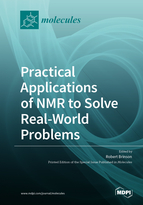Practical Applications of NMR to Solve Real-World Problems
A special issue of Molecules (ISSN 1420-3049).
Deadline for manuscript submissions: closed (31 August 2021) | Viewed by 31416
Special Issue Editor
Interests: biologics; proteins; nucleic acids; NMR; higher-order structure; chemometrics; method harmonization
Special Issue Information
Dear Colleagues,
Once primarily within the purview of academia, nuclear magnetic resonance spectroscopy (NMR) is now routinely used in many industry sectors, government agencies, and other applied research activities with great benefit. Such areas include agriculture, metabolomics, and complex mixtures, manufacturing and process monitoring, pharmaceuticals (biologics and small molecules), national security, forensics, energy, and renewables. Many similar technical challenges, and often regulatory burdens, are shared across these fields, yet there is often little cross-talk between the various NMR practitioners in each of these focused areas. Greater sharing of experience and expertise amongst practitioners of applied NMR would be of benefit to all.
With this in mind, this Special Issue will collect original papers and review articles across the broad array of current NMR applications in solving practical problems, with the goal of enabling cross-talk between academic, industrial, and government scientists. Emphasis will be placed on papers that address practical applications, including more basic research-oriented articles that seek to translate NMR methods into a new or different sector.
Dr. Robert Brinson
Guest Editor
Manuscript Submission Information
Manuscripts should be submitted online at www.mdpi.com by registering and logging in to this website. Once you are registered, click here to go to the submission form. Manuscripts can be submitted until the deadline. All submissions that pass pre-check are peer-reviewed. Accepted papers will be published continuously in the journal (as soon as accepted) and will be listed together on the special issue website. Research articles, review articles as well as short communications are invited. For planned papers, a title and short abstract (about 100 words) can be sent to the Editorial Office for announcement on this website.
Submitted manuscripts should not have been published previously, nor be under consideration for publication elsewhere (except conference proceedings papers). All manuscripts are thoroughly refereed through a single-blind peer-review process. A guide for authors and other relevant information for submission of manuscripts is available on the Instructions for Authors page. Molecules is an international peer-reviewed open access semimonthly journal published by MDPI.
Please visit the Instructions for Authors page before submitting a manuscript. The Article Processing Charge (APC) for publication in this open access journal is 2700 CHF (Swiss Francs). Submitted papers should be well formatted and use good English. Authors may use MDPI's English editing service prior to publication or during author revisions.
Keywords
- NMR
- Pharmaceuticals
- Forensics
- Agriculture
- National security
- Food science
- Metabolomics
- Energy and renewables
- Process and reaction monitoring
- Technology translation







